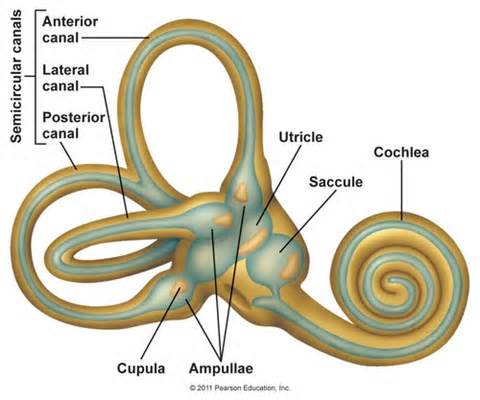Does it feel like the room is spinning? Maybe you have BPPV
Ever feel like the room is spinning when you lay down, stand up quickly or just change the position of your head? Maybe you have something called BPPV.
What is BPPV?
BPPV is short for Benign Paroxysmal Positional Vertigo. It is a disorder of the inner ear that results in vertigo (spinning sensation) with specific changes in head position.
Benign: "Harmless" (non life-threatening)
Paroxysmal: Sudden recurrance, short, frequent and steroetypical
Positional: Relating to head position with respect to gravity
Vertigo: A subjective feeling of whirling / spinning / dizziness
BPPV is a very common cause of vertigo / dizziness. It affects up to 2% of the population and accounts for 20-50% of all vertigo or 'dizziness' cases.
The vestibular organ (located in your inner ear) is a sensory organ that sends messages about movement and changes in position to your brain. It is made up of 3 semi-circular fluid-filled canals and 2 otolith organs which contain the sensory nerves that communicate movement information when stimulated and also send information to your eye muscles to control your gaze and your body to help it stay upright.
 The otoliths contain 2 beds of calcium carbonate “crystals” called otoconia. BPPV results when pieces of these otoconia dislodge or break away and move into the semi-circular canal system, either floating in the fluid within one or more canals, or adhering to the “cupula” at the end of the canal. The abnormal presence of these crystals in the canal now sends incorrect information about head movement to the brain, which can cause vertigo, abnormal eye movements (nystagmus), and imbalance.
The otoliths contain 2 beds of calcium carbonate “crystals” called otoconia. BPPV results when pieces of these otoconia dislodge or break away and move into the semi-circular canal system, either floating in the fluid within one or more canals, or adhering to the “cupula” at the end of the canal. The abnormal presence of these crystals in the canal now sends incorrect information about head movement to the brain, which can cause vertigo, abnormal eye movements (nystagmus), and imbalance.
Causes
Currently for majority of cases, the cause of BPPV is unknown. However in some cases, it can be due to the following:
- Rapid acceleration/deceleration of the head (e.g. head trauma, concussion, whiplash)
- An existing vestibular problem (e.g. neuritis, labyrinthitis, Meniere’s)
- Natural age-related changes to the otolith organs
- Following significant periods of inactivity
- Following certain surgical procedures involving specific positioning of the head
Risk Factors
- Aging (especially >60 years old)
- Possibly existing osteopenia/osteoporosis
- Traumatic brain injury
- Prior episodes of BPPV or a family history of BPPV
Signs and Symptoms
Potential signs and symptoms of BPPV include the following:
- Intermittent bouts of a spinning type of dizziness that is usually short in duration (less than 2 minutes)
- True sensations of vertigo (room is spinning around you, or you feel as if you are spinning)
- Triggered by specific movements of the head, e.g. rolling in bed to the right or looking up
- Irregular eye movement that occurs with the vertigo
- Mild or no symptoms when your head is still
- Nausea, vomiting and lightheadedness
Treatment
Treatment aims to move the head in various directions to enable the otoconia (cystals) to dislodge and/or move through the canal and migrate back to the vestibule where they originated.
For the vast majority of cases, treatment is highly successful and relatively quick. However this is dependent upon proper diagnosis and appropriate application of the correct manoeuvre.
An assessment will determine what type of BPPV exists. Then manoeuvres specific to that variant would be applied. This can be manually performed by a qualified therapist, or can be taught as a home exercise. The Epley Manoeuvre (Maneuver) is the most well known corrective procedure that is often used to treat a posterior and anterior canalithiasis. Other treatment manoeuvres include Gufoni’s, Semont’s, Brandt-Daroff, and the horizontal roll among others.
Once the BPPV is resolved, some patients may require some physiotherapy to address residual dizziness.
Medications: Anti-nausea drugs may be prescribed by your GP to assist with the associated nausea. This will not cure BPPV as it does not address the dislodged particles.
Prognosis
For most people BPPV can be easily corrected within 1-3 treatments. However having BPPV does increase the likelihood of getting BPPV again. This is largely due to the continued presence of risk factors that accompanied initial onset.
The more complicated variants of BPPV can require more time and more manoeuvres to resolve. However these cases eventually improve as well.







